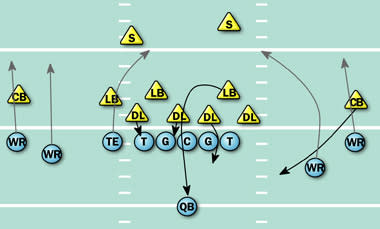Pats in a hurry to fix pass-rushing decline
Also in this article:
Next Surveillance:
Packers
More NFL:
Editor's note: Yahoo! Sports will examine the biggest weakness of the 2009 season for every team and explain how the franchise can address the issue. The series continues with the New England Patriots, who finished first in the AFC East (10-6).
Biggest problem in 2009: A downward pass-rushing trend

The Patriots' Tully Banta-Cain(notes) led the team in 2009 with 9½ sacks.
(Jim Rogash/Getty Images)
In the last decade, the New England Patriots have won three Super Bowls and come within a touchdown of the only 19-0 season in NFL history. In 2008, they went 11-5 with a backup quarterback who hadn't started a game since high school. Generally speaking, when Bill Belichick's teams encounter personnel problems, there's enough replacement talent on the roster – and enough intelligence in the front office – to recover in a hurry. But during the past two seasons, one issue has bedeviled this franchise with an unusual lack of resolution – the Patriots can't consistently rush the passer.
In their 18-1 season in 2007, the Pats sacked enemy quarterbacks 47 times in the regular season, and they ranked second in Football Outsiders' Adjusted Sack Rate metric. Since then, they've totaled 31 sacks in each season and ranked 18th in ALY in each season. The sack totals are the lowest since Belichick's first year as New England's head coach in 2000. A defensive coach throughout his estimable career, Belichick can't be happy about it. Even more distressingly, the defense has decreased every year since 2007 in hurry rate, which ranks quarterback hurries divided by opposing pass attempts. Quite often, a high hurry rate behind a low sack total is indicative of improvement in the next season. But as the sack totals have gone down, so have the hurry rates – from 2.6 percent above the NFL average in 2007, to 1.6 percent above average in 2008, to 0.4 percent below average in 2009.
What happened? The Pats never replaced Mike Vrabel's(notes) 12½-sack season in 2007, but Vrabel followed up with just four sacks in 2008. No New England defender has amassed 10 or more sacks since then, though linebacker Tully Banta-Cain put up 9.5 last year. In replacing their older defenders, the Pats have lagged behind in establishing young pass rushers. Banta-Cain played in New England from 2003 through 2006 and then spent two seasons in San Francisco before coming back home in 2009. New England drafted one mid-round outside linebacker each in 2008 and 2009 – Shawn Crable(notes) and Tyrone McKenzie(notes) – but the team has had horrific injury luck at the position. Crable spent his first two NFL seasons on Injured Reserve, and McKenzie missed his rookie season with a torn ACL. And while New England's 1.7 percent Defensive DVOA was decidedly average, the Pats' defensive efficiency declined severely when they rushed more than four defenders in 2009. They allowed 9.1 yards per pass overall, 8.7 when rushing three or four and 9.8 when rushing five or more.
The 2010 solution: Go back to the well

Cunningham
While Crable and McKenzie might surprise, the Pats clearly understood the need to hit the draft once again for their future edge rusher. As part of its Florida-heavy draft (one wonders why Belichick didn't go whole hog and draft his old buddy Urban Meyer, too), New England took end Jermaine Cunningham(notes) and hoped that he wouldn't continue the trend of disappointing Gators ends (see: Derrick Harvey(notes) and Jarvis Moss(notes)). After missing the Senior Bowl and the Combine with a shoulder injury, Cunningham put on a great show at a private workout for NFL teams in early April. He's a good fit for New England's hybrid fronts because of his experience playing standing up and with his hand on the ground. Perhaps his most impressive characteristic is his explosion off the line at the snap, which serves him equally well in space and when he's looping inside.

Figure 1
That's how Cunningham got one of his seven senior-year sacks, against the no-huddle offense of Mississippi State in a Week 7 win. Late in the fourth quarter, he looped inside against a spread set and took quarterback Tyson Lee down (Figure 1). In the pros, he'll have to improve at finishing the tackle when he gets his hands on an offensive player – for all his speed and short-area quickness, Cunningham will whiff on tackles and miff Belichick. But on this play, he showed an innate sense for finding gaps and blasting through protections.
If the Patriots are patient with Cunningham, especially as he develops his ability to make moves without his hand down, they could be rewarded with a young defender like that of another college star who made a similar NFL adjustment: Green Bay's Clay Matthews(notes). At USC, Matthews was very strong when it came to looping inside (as we showed in the Seattle Seahawks "Under Surveillance" piece), and he turned that blast off the snap into a stellar rookie season.
